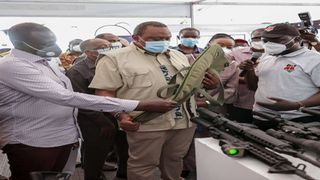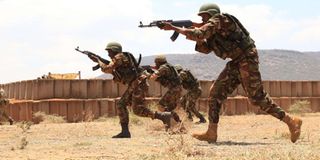
President Uhuru Kenyatta on a guided tour of exhibition booths by young Kenyan techies at the KWS Law Enforcement Academy in Manyani, Taita Taveta County. Also present is Deputy President Dr William Ruto.
| PSCUNews
Premium
Weapons from Uhuru secret arms project deployed to Somalia
What you need to know:
- Intelligence officials confirmed the assistance of NIS in the recruitment of the young innovators.
- The arsenal modified and manufactured in Kenya is part of the weaponry that the KDF 10th Battle Group (10BG), which started moving into Somalia early this month, is using.
In a historic fete, Kenyan troops will, for the first time, be armed with weapons and weapon systems manufactured locally following the success of a secretive manufacturing and innovation enterprise, the Saturday Nation can reveal.
The arsenal modified and manufactured in Kenya is part of the weaponry that the Kenya Defence Forces (KDF) 10th Battle Group (10BG), which started moving into Somalia early this month, is using.
The 10th KDF Battle Group will see KDF prepare for the anticipated withdrawal of troops under the Somali Transition Plan aimed at the gradual transition of security responsibilities to Somalia’s security institutions.
The weapons and security systems were modified and manufactured by Kenyans in their 20s, in what has been one of the country’s best kept secrets. Kept away from the public, the young innovators have been working on the confidential project for two years under what is dubbed as the National Security Industrialisation Projects, we can reveal.
“Some of Kenya’s best kept secret and Kenya’s best kept assets is sitting in this room right here,” President Uhuru Kenyatta said on October 17, when he led ministers to the KWS Law Enforcement Academy in Manyani for a Cabinet meeting.

Kenyan soldiers during the Kenya Defence Forces and British Army troops joint training at the Kenya Defence Forces School of Infantry in Isiolo County on October 7, 2020.
State House announced that the President was in Manyani to “receive progress reports of several national security sector technology projects and preside over an innovation exhibition by young Kenyan techies.”
But, from our inquiries, the event was more than that. It was the first time that the President was making public the existence of the young techies recruited with the help of the National Intelligence Service (NIS) from universities.
Senior government, intelligence and military officials have told the Saturday Nation that the group is “Uhuru’s secret weapon against terror” and part of his effort to boost national security.
“They were recruited from university with recommendations of lecturers,“said Government Spokesperson Col (Rtd) Cyrus Oguna. “While some of them are fresh graduates, a number got into the project straight from lecture halls. None of them is above 30 years old.”
Our inquiries have revealed that the NIS helped in picking of the group described as “some of the best brains” from universities.
Intelligence officials confirmed the assistance of NIS in the recruitment of the young innovators.
“They come from every sector of our great republic,” the President said about the youth numbering about 700 in his speech at Manyani.
To keep it strictly confidential, the Head of State is said to have allowed the use of a confidential fund from the Office of the President to maintain the young techies with sources saying that the Head of State made the decision to do so to avoid politicising their funding.
And as it seems, the government is not keen to reveal the source of the funding of the innovation programme.
State House Spokesperson Kanze Dena told the Saturday Nation that she could not confirm if the funding came from the Office of the President while the Ministry of ICT and Youth Affairs PS Jerome Ochieng said that the Government Spokesperson was better placed to respond to queries about the project.
“Other than what was exhibited in Manyani, I am not at a position to provide more details on what we, the young innovators, have been able to modify and manufacture due to the sensitive and confidential nature of their work,” Col (Rtd) Oguna said.
The President’s efforts seem to have paid off, as some of their innovations have already been put to use in surveillance missions and complex security operations by KDF’s Special Forces in neutralising targets.
Some of the targets were taken down deep inside enemy territory in Somalia.
Together with experts from the military, the young techies have also devised innovative technology to deal with the troubling improvised explosive devices, which are commonly used by al-Shabaab militants.
As part of the National Security Industrialisation Projects, the young techies have come up with a raft of surveillance equipment, weapons system controls, guns and ammunition and drones.
Notable among them is the CMZ-4 Assault rifle. The gun has an internal diameter of the gun barrel is 5.56×45mm and complies with NATO standards. The gun has a muzzle velocity of 875 m/s and a trigger force of 15-30 N. It can hold up to 30 rounds which are loaded using a gas or direct impingement principle.
KDF has tested and approved the rifle, which is now being used by Kenyan troops. Previously, Kenya could only manufacture ammunition for small arms through the Kenya Ordnance Factories Corporation (KOFC), a state corporation under the Ministry of State for Defence.
The youth have also come with geospatial, airborne geophysical and cyber security innovations ranging from the National Integrated Identity Management System (NIIMS), popularly known as Huduma Namba, the digitisation of the Occurrence Book in police stations, an app to help collect fines in petty offences, as well as TaifaPay, a revenue payment and collection system.
Key among the innovations is the geospatial data project, a massive exercise that has seen new maps of Kenya created since 1970.
At the moment, Kenya still refers to topographical data sets developed during the pre-independence period.


